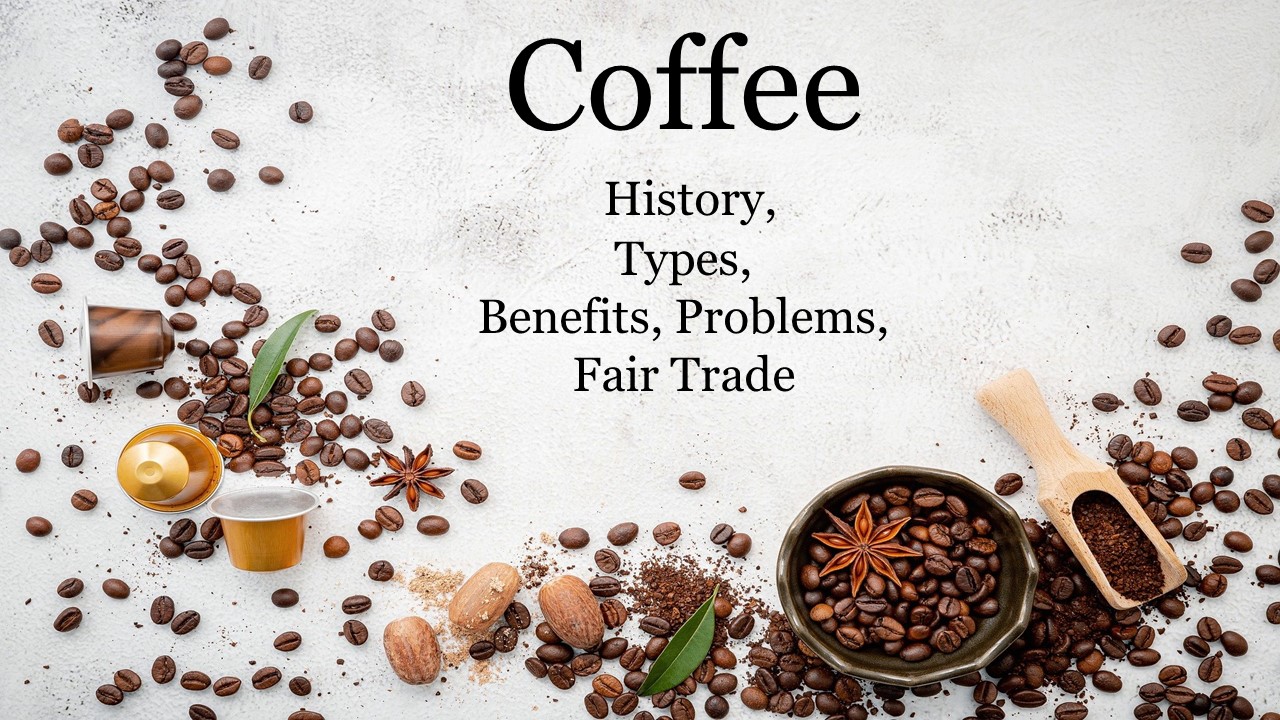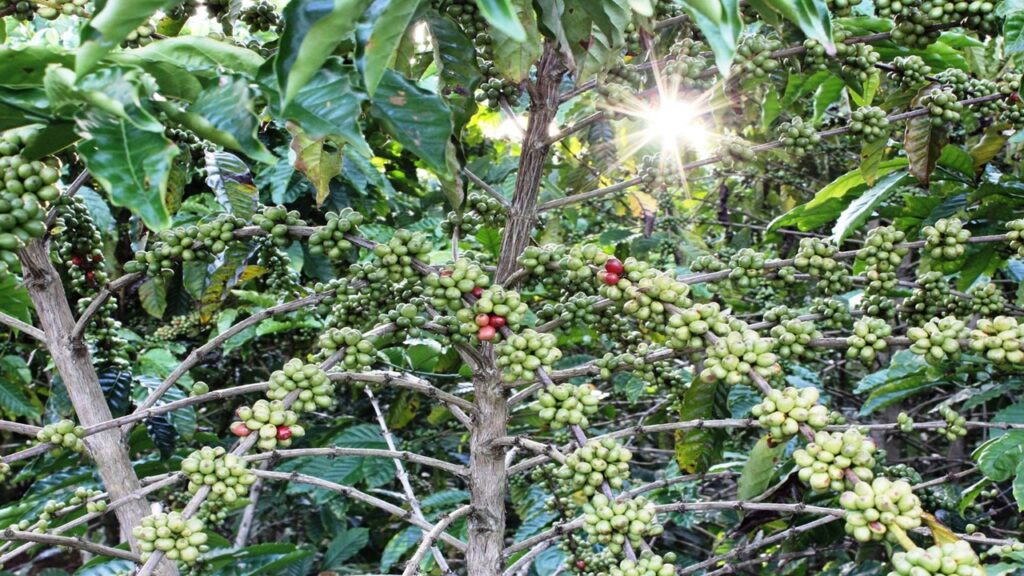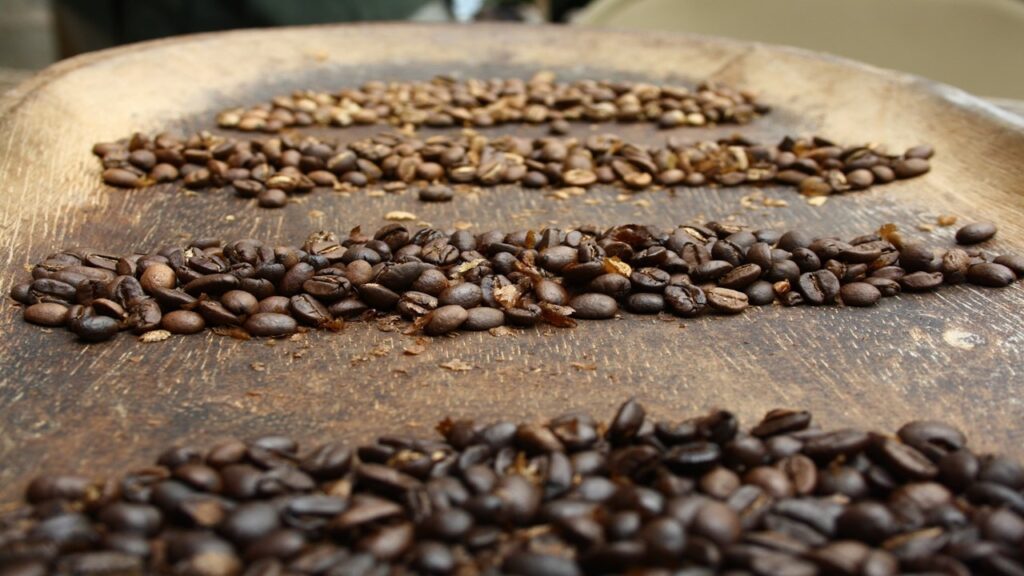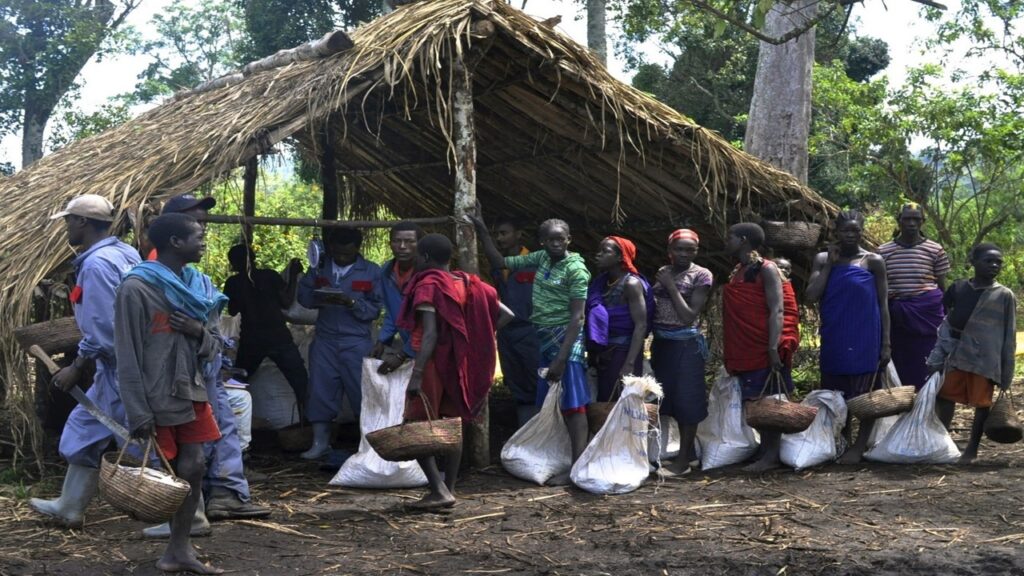Coffee: History, Types, Benefits, Problems and Fair Trade

Coffee is one of the most popular beverages that people consume around the world. In fact, researchers estimate that globally, we consume around 2.25 billion cups every day! In the last 50 years, its production increased from 4.2 m tonnes in 1970 to more than 10 m tonnes in 2019-20. What’s more, some nations depend almost completely on coffee export as a source of income. Today, we make so many different drinks with the beans and it is the younger generations that are driving the demand.
History of coffee
Basically, we can trace the history of coffee to Ethiopia sometime in the late 14th century. Ethiopians mainly used it as a stimulant. After that, in the middle of the 15th century, evidence shows that people in the Sufi monasteries of Yemen drank it.
Then in the 16th century, it spread in the Middle East, Turkey, Persia, South India and Northern Africa. Eventually, it found its way into Italy through the intense trade in Venice and reached the rest of Europe. As trading continued, it got into Indonesia and finally to America.
What coffee plants/trees look like
In general, the brew that we drink comes from the plant, Coffea. For cultivation purposes, we typically prune it to low levels. But, in the wild, it can grow to a big tree up to 9 meters high.
Green waxy leaves grow on the plant and cherries contain the bean that we roast and brew. Cherries start out as green and become red when they mature.

Countries that grow coffee
Plants generally grow in rich soil, with frequent rain, shaded sun and mild temperatures. Thus, they thrive mainly in the Equatorial zone between latitudes 25° North and 30° South of the world. We call that region the ‘Coffee Belt’.
More than 50 countries today grow it including Mexico, Puerto Rico, Costa Rica, Ethiopia, Kenya, Yemen, Indonesia and Vietnam. But, actually only four main countries produce the world’s coffee: Brazil, Vietnam, Columbia and Indonesia.
The United States is the biggest importer followed by Germany and Italy.

Species of coffee
We consume beans from two main species
As it is, we consume beans from two main species: Coffea arabica (Arabica) and Coffea canephora (Rustica). People generally prefer Arabica, the one Ethiopians originally discovered, because of its sweeter taste. And as a result, it also has a higher price on the market.
124 species occur in the wild
However, there are at least 124 coffee species that we know occur in the wild. They grow typically in tropical Africa, the Indian Ocean islands, Asia and Australasia. People have also used them as a substitute for Arabica.
Species threatened with extinction
Of these, 75 species are threatened with extinction which represents 60% of all coffee plants. 43 of these occur mainly in Madagascar and 9 species have not been seen since 1940.
What does coffee contain?
Though most of us mainly associate coffee with caffeine, it actually contains a complex mixture of compounds. In reality, there are around 1000 compounds in it which are mostly polyphenols. Some common elements are also vitamin B3, potassium and magnesium.
Polyphenols
Polyphenols are micronutrients that come mostly from plants. Coffee contains many polyphenols, especially the phenolic acids, caffeic acid and chlorogenic acid.
A single cup of the brew may contain around 20 and 675 mg of chlorogenic acids.
Diterpenes
Among the phenols are also two diterpenes: cafestol and kahweol. Research shows that these molecules help to reduce the risk of colon and rectum cancers.
Caffeine
Caffeine is the most active ingredient in coffee. It was isolated in 1820 and has been widely studied. Though caffeine also occurs in tea leaves and other plants, the highest concentration is in coffee. In general, a standard cup of ground roasted coffee can contain around 85 mg of caffeine. Instant coffee can contain 60 mg of caffeine and decaffeinated coffee 3 mg.
Caffeine is a strong stimulant
Most people actually like coffee because caffeine is a strong stimulant. It stimulates the central nervous system, increases our alertness and energizes the body. Caffeine normally reaches the highest concentration in our system within 15 minutes to 2 hours of drinking the brew.
Roasted coffee
So, to get our particular type of brew, we must first roast the beans. In general, the composition of a cup of coffee varies a lot. It typically depends on the roasting process whereby the compounds change.
In this way, it results in the particular aroma, colour and flavour of our desired brew. We can see this in the colour of the beans which can range from light to dark brown.

Roasted beans composition
By composition, roasted beans contains:
38-42% carbohydrates, 23% melanoidins, 11-17% lipids, 10% proteins, 4.7% minerals, 2.4% aliphatic compounds and 1.3-2.4% caffeine.
Types of coffee drinks
There are so many types of coffee brew around the world! Each nation has its particular way of making it with different ingredients. Some like it hot, others cold.
The most common ones are listed below.
10 Hot coffee brews
1. Black coffee
Simply a mix of ground beans with water.
2. Expresso
Basically, expresso originates from Italy. It is a small, strong shot and the most common type of coffee that we drink. As it is very strong, it also forms the base of many coffee drinks.
3. Americano
An americano is simply an expresso to which we add hot water.
4. Long black
We typically make a long black with two shots of expresso and a small amount of water.
5. Café latte
Latte as in milk. We make the café latte by mixing an expresso with milk. We also serve it with a thin layer of milk foam on the top.
6. Café mocha
A café mocha is a mix of café latte with whipped cream and chocolate sauce.
7. Café au lait
Of French origin, we make the café au lait by mixing dark filtered coffee with warm milk.
8. Cappuccino
The cappuccino consists of an expresso and a milk foam layer.
9. Ristretto
A ristretto is an expresso that we make with half the amount of water in an expresso. So, it is quite a strong drink.
10. Flat white
A flat white is a mix of expresso and steamed milk, with a higher coffee to milk content.
10 Cold coffee brews
1. Cold brewed
Cold-brewed drinks are now becoming quite popular. We make it by brewing freshly ground beans in cold water. Then, we let it stay overnight and drink it as it is or with cream or honey.
2. Iced latte
An iced latte is an expresso, cold milk and ice mixture. We can also add syrup or sugar to it.
3. Iced coffee
To make iced coffee, we brew a cup of coffee and let it cool with ice. We can then add milk, syrup or honey to it.
4. Japanese iced coffee
Here, we brew ground beans in hot water but immediately pour it over ice. In this way, it releases its wonderful flavours.
5. Expresso tonic
We add two shots of cooled expresso to tonic water, ice and some lemon juice to make an expresso tonic.
6. Nitro coffee
A nitro coffee is a special drink that has a beer like feel. The dispensing system adds nitrogen to the cold brew making it frosty.
7. Freak shake
A freak shake is basically a cold brew that we blend with ice. We can then add any type of topping to it like cream, chocolate, fruits etc.
8. Frappe
We make a frappe by blending an expresso with milk and ice.
9. Iced mocha
As the name says, we prepare an iced mocha like an iced latte. But we garnish it with cream and chocolate sauce like a café mocha.
10. Café affogato
We make a café affogato simply by pouring an expresso over vanilla ice cream.
Benefits of coffee
1. Health benefits
The main health benefit is that it increases alertness. Probably why many people consume it as well. It also enhances the mood and reduces symptoms associated with tremors and Parkinson’s disease.
2. Helps to power economies
Undoubtedly, it is an important international commodity. The value of the coffee industry reached $90 billion over the past decade. Right now, some 25 million farmers produce almost 80% of the world’s coffee. Additionally, around 125 million people work on farms for their livelihoods.
3. Provides environmental services
In general, coffee plants reduce soil erosion, help in water management and provide habitats for various birds and small animals. They also help to store carbon especially when they grow in shaded forests.
4. Socio-cultural importance
Today, our society has normalized drinking coffee. In the 1980s, merely 50% of the adult population consumed it. Today, it is the standard to meet up with someone for business or casually and share a coffee. What’s more, with the wide variety that exists, we can customize ours as we want.
Problems with coffee
1. Health problems
Unfortunately, some people cannot tolerate high levels of caffeine. So, for them, there is decaffeinated coffee with relatively low levels of caffeine. In fact, we consume some 10-15% of decaf around the world.
Nonetheless, high doses of caffeine can also lead to restlessness, anxiety, agitation and tension.
2. Plantations cause deforestation and threaten biodiversity
With the expansion of tropical coffee plantations, it becomes a threat to biodiversity. Communities cut down forests to cultivate coffee plants. Consequently, it can affect bird populations, bats, ants and other small mammals.
Sometimes, people also deforest plantations with various plant species to plant a single economically important one.
3. Society becomes addicted
That people love this brew is mainly due to the alertness that caffeine causes. However, it also becomes addictive. We, society as a whole, have become addicted to it.
Today, especially, it is the younger generations that are driving the demand for high-quality coffee. Statistics show that it is mainly young adults in the age range 18-24 years that consume it the most. Youngsters in the age range 13-18 years second them with cold-brewed freak shakes.
Fairtrade coffee
Fairtrade means that people in developing countries who work in coffee plantations get a fair price for their work. Generally, as these nations are poor, big companies exploit farm workers and children too must work. At the same time, farmers also use chemicals that can affect their health.

Farmers have a say in transactions
So, with fair trade, farmers have a say in transactions. They thus cultivate according to their capacity, with the materials that they have in a sustainable manner. Basically, fairtrade is centred on the interests of poor farmers so they can get enough money to afford life’s essentials. In this way, it prevents the exploitation of children and safe working conditions for adults.
So, we must remember to buy fair trade coffee for farmers to get better working and living conditions.

There are just so many types of coffee, especially for me. I am not a coffee drinker but do enjoy a good cup of coffee from time to time. But this list is just so overwhelming